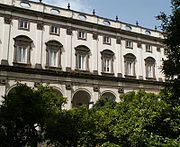
Girolamini
Encyclopedia

Naples
Naples is a city in Southern Italy, situated on the country's west coast by the Gulf of Naples. Lying between two notable volcanic regions, Mount Vesuvius and the Phlegraean Fields, it is the capital of the region of Campania and of the province of Naples...
, southern Italy
Italy
Italy , officially the Italian Republic languages]] under the European Charter for Regional or Minority Languages. In each of these, Italy's official name is as follows:;;;;;;;;), is a unitary parliamentary republic in South-Central Europe. To the north it borders France, Switzerland, Austria and...
. It is located directly across from the Cathedral of Naples
Cathedral of Naples
Naples Cathedral is a Roman Catholic cathedral, the main church of Naples, southern Italy, and the seat of the Archbishop of Naples. It is widely known as the Cattedrale di San Gennaro, in honour of Saint Januarius, the city's patron saint, but is actually dedicated to the Assumption of the...
on via Duomo.
The first cloister or "chiostro maiolicato" is on the site of an earlier building,the Palazzo Seripando, which was donated to the priests of the Congregation of the Oratory of St. Phillip Neri in 1586. The original building was demolished and construction started on the new structure in 1592 on plans by the Florentine architect Giovanni Antonio Dosio
Giovanni Antonio Dosio
Giovanni Antonio Dosio was an Italian architect and sculptor.He was born in San Gimignano. A student of Ammanati, with whom he realized the Villa dell'Ambrogiana, Dosio worked primarily in Rome and Florence , with some commissions that took him to Naples.During his early years in Rome, where he...
. The much larger second cloister, dating from the 17nth Century, is reached from the first and in it are found the entrances to both the "Quadreria" or art collection, previously housed in the sacristy of the Church, and the magnificent library of the Oratorian Fathers, now run by the Italian state. The Church dedicated to the Nativity of the Madonna and All Saints has its principal entrance on the Piazza Girolamini reached from the via Tribunale. It is also the work of Dosio as well as that of Nencioni and is in the style of the Florentine Renaissance: a Latin cross with three naves supported by arcuated colonnades and with lateral chapels. The Church contains works by Luca Giordano, Francesco Solimena, Sassoferrato, Francanzano and other artists. The lavishly gilt ceiling was badly damaged during aerial bombardment in February of 1944, but has been partially restored. Later architects, such as Ferdinando Fuga
Ferdinando Fuga
Ferdinando Fuga was an Italian architect, whose main works were realized in Rome and Naples in the Baroque style.-Biography:Born in Florence, he began to work in that city as a pupil of Giovanni Battista Foggini. In 1717 he moved to Rome, to continue his apprentice studies...
who rebuilt the façade in 1780, also worked on the building.
The Church and complex take their name from that which was first applied to the priests of the Oratory and which is derived from the Church of San Girolamo della Carita in Rome where St Philip Neri first established his religious exercises.

